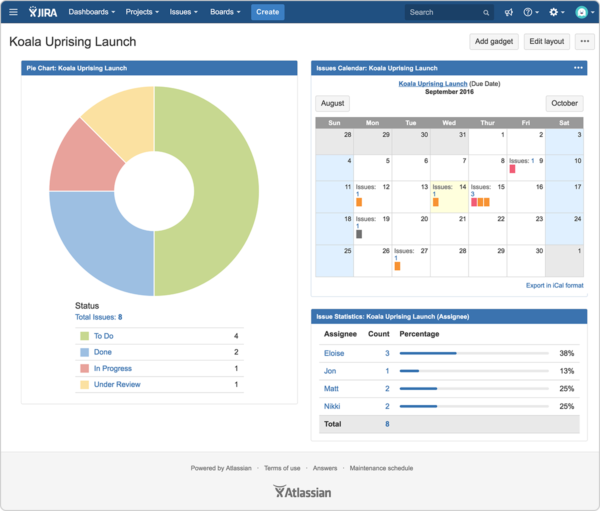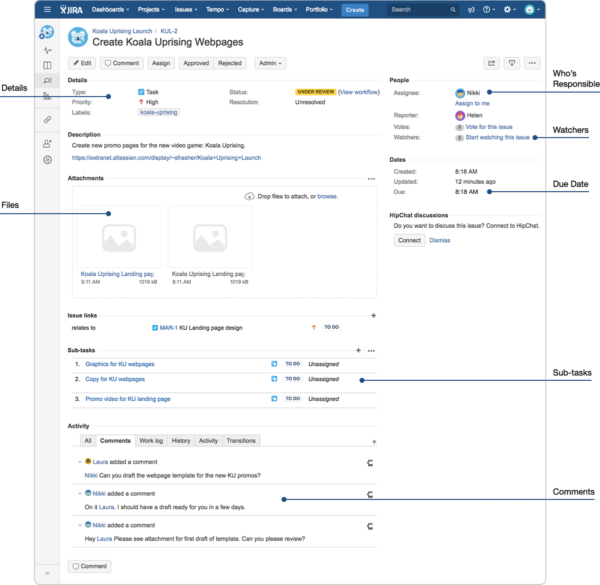If you’ve ever launched a marketing campaign, then you know it’s no easy task. There are a flurry of things to do and keep track of, like creative assets, copy, people, and – most importantly – due dates. It seems like half your time is spent chasing teammates down to get status updates, while the other half is spent organizing everything involved in the campaign.
How does your marketing team organize its campaigns and product launches? Maybe you create a checklist that looks like this:
To Do:
Create messaging and positioning
Create web pages
Write blog
Send email announcement
Create social media plan
Film video
Sign legal contracts
Draft press release
And so on…
The dreaded list never seems to end. And if you think about it, each task actually represents a person, or team of people, who need to complete it by a certain due date. And that person or team breaks down that one task into many different deliverables that need to be coordinated and worked on. In sum, it takes a village to launch a marketing campaign. Whether that village is a large corporate marketing team of 100+, or a small and scrappy handful of a few colleagues working with outside vendors, you need everyone to pitch in.
And while you’re handling the checklists of your campaign, you need to report up to your manager, who likely wants an update. How do you track all these tasks, subtasks, and the people working on it? There are a few known methods. 1. Ping your coworker. 2. Gather everyone and have (multiple) meetings. 3. Send emails and forget to cc: someone.
 Pinging your coworker can disrupt their focus. Meetings can disrupt and use a team member’s valuable time. And email – isn’t it just the worst trying to read everyone’s replies and forwards? We’ve seen a lot of teams go through this pain. And it ends up in miscommunication, delayed deliverables, incorrect assets and whatever else causes a marketer headaches.
Pinging your coworker can disrupt their focus. Meetings can disrupt and use a team member’s valuable time. And email – isn’t it just the worst trying to read everyone’s replies and forwards? We’ve seen a lot of teams go through this pain. And it ends up in miscommunication, delayed deliverables, incorrect assets and whatever else causes a marketer headaches.
But some teams have found comfort and peace of mind by following in the footsteps of their software team counterparts who may be using Jira Software. Jira Software is a project management tool that helps software teams plan, track, and prioritize their tasks so they can release great software. Product marketing teams and other types of marketing teams can follow the same methodology but in the context of their business needs with Jira Core. How? Jira Core is the project and task management solution built for business teams, in particular marketing teams, to help them plan, track and deliver projects on time. Let’s take a peek into how Jira Core can help your organize your work.
Jira Core helps product marketing teams report and analyze the overall health of the project
Scenario 1: Your manager needs an update on the project progress.
Manager: “Are we set to launch on time?”
You: [Quickly checking your Jira Core Dashboard.] “We’ve only finished a fourth of our tasks and we still haven’t started half of them. It looks like John is only has 1 task on his plate. Let’s see if we can re-assign some tasks.”
With the Jira Core Dashboard you can get a high level overview of the status of your project – what’s been done and what’s still left to do. You can build this dashboard to not only highlight your tasks, but the tasks of the rest of your team segmented by assignee, task status, or what needs to be approved. In addition, with a calendar view, you can see when all the tasks are due and see if your team will be able to deliver the project on time.
Different colors indicate a task’s priority. Red means it’s high priority so it’s best to keep a watchful eye on those, and gray means low priority, so it might be okay if those due dates slip by a few days. And since these dashboards are customizable, you can see how many tasks are assigned to your team or use filters to see the tasks that are most important to you. Clicking on one of the tasks in the calendar view will provide you the task details.

PS: Screenshots are examples only. We all know that there are more than 8 tasks in a launch.
Jira Core helps product marketing teams see all task information in one central place.
Scenario 2: Get a status update from your teammate.
You: “What’s the status on the webpages?”
With Jira Core, you actually won’t send that email and enter into a FW: RE: spiral. You can go directly into Jira Core and see all the information you’re searching for. You’ll know who’s accountable for the task at hand, see its status and all the comments made. You can also see all the sub-task dependencies to ensure that all the tasks are complete. Plus, you won’t have to search for that most updated file, it’s all there. With the due date looming, you’ll always have a pulse on your team’s ability to deliver the task (and sub-tasks) on time.
Jira Core provides the basic information you need for your task, and because every task screen is customizable, you can include the pertinent information your team needs in the details section. For example, you can add a field for a URL, text box for target market, or a checkbox to select the product this task pertains to. You can still stay up-to-date by adding yourself as a “watcher” to the task so you’ll be notified of every update. Now, every team member will be up-to-date with all project and task information in all in one place.

Checklists in your notebook – gone.
Email updates – gone.
Meetings – well, mostly gone.
Now you don’t have to break a sweat or stalk your teammates for updates, you can organize all your marketing project information all in a tool made just for you – Jira Core.
